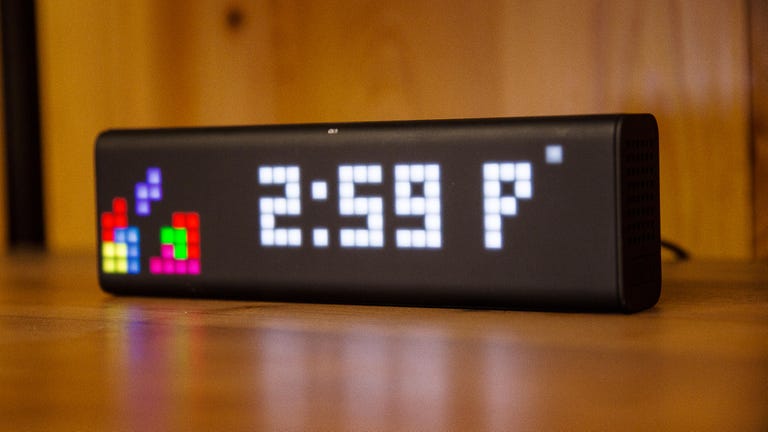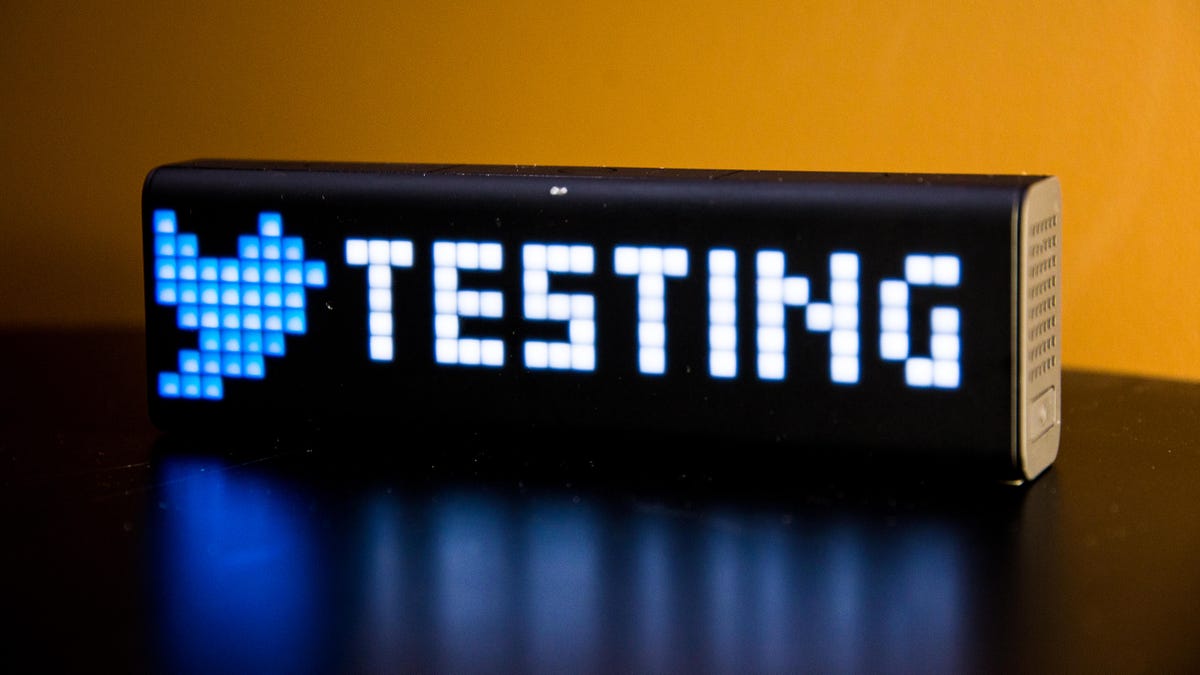 Why You Can Trust CNET
Why You Can Trust CNET LaMetric Time review: An overpriced gizmo from six years ago suddenly gets interesting
LaMetric's likable pixel display is old and overpriced -- but it hints at huge potential for the company's next product.
It happens. Smart home gadgets come out faster than we can test them, and we end up late to the review. It's a busy beat!
The Good
The Bad
The Bottom Line
Never has this been more true than with LaMetric Time. First conceived nearly six years ago, the customizable, pixelated desktop clock that can display smart home alerts and social notifications went on to secure funding on Kickstarter, and is now available at a much-too-steep $199. It always struck me as a nifty-looking novelty that cost way too much, so we never got around to testing it out.
Things changed at CES 2019, though, when LaMetric resurfaced with a new product: pixelated LaMetric Sky LED wall panels that can either serve as an elegant, abstract art piece or, if you arrange enough of them into a rectangle, as a wall-mounted version of the Time's notification center. They looked great in person in Las Vegas, and the pixelated approach lets them do things that the current top name in LED wall panels -- Nanoleaf -- can't.
Pricing on those panels isn't set yet, but LaMetric's team tells me that they're aiming to compete with what's already available, which would peg them at somewhere around $200 for a starter kit.
All of that suddenly makes the Time interesting -- if only to get a sense of the features that might translate well to your walls, as well as the potential hiccups that could derail the idea altogether. Six years in and still 200 bucks, the Time still costs at least twice as much as I'd be willing to spend on it, but with terrific-looking wall panel versions coming at the end of the year, this amped-up desk clock merits a closer look.
Definition of a desktop doodad
You can link LaMetric with smart lights from Lifx or Philips Hue, then turn things on and off with a tap.
The LaMetric Time is an unassuming-looking black bar of plastic with a pixelated LED display on its front face and a trio of buttons up top. Plug it in, and it'll start broadcasting a Wi-Fi signal. Download the LaMetric app, connect with that signal and sync it up with your home network, and you'll be able to customize and control the display right from your phone.
Your options are pretty vast, with a long list of user-created, Time-specific "apps" that you can download from within LaMetric's smart phone app. Each one enables your Time to show you something new. Usual suspects like Twitter mentions, Facebook likes and Slack notifications are all accounted for, along with apps for weather updates and breaking news headlines and others that will display a countdown timer or a stopwatch.
There's a pretty sizable library of free apps that you can download for your Time's display.
Other apps let the Time move beyond passive display in order to take a more active role. For instance, smart home apps for brands like Philips Hue, Lifx and Nest let you see the status of your gadgets at a glance, then turn things on or off with the press of a button. A built-in internet radio app lets you pick your favorite streaming stations and play them through the speaker built into the device (I programmed mine to stream Live Phish Radio with just a tap). And yep, this thing works pretty well as an alarm clock, too.
You can cycle between all of those app functions by pressing the left and right buttons on the top of the device, or you can set the LaMetric Time to cycle through your apps automatically. I found the latter approach to be a bit distracting on my desk at work as I tested this thing out, so I ended up leaving it locked on the main clock display, with notifications for things like Twitter mentions or new emails from the boss only showing up as they occurred.
That main, default display also lets you pick a custom icon from an extensive library of user-created options. If none of those work, you can create your own, complete with surprisingly simple controls for animating it.
All of that makes it really easy to personalize the LaMetric Time to your specific interests -- but if you really want to unlock its full potential, you'll need an assist from IFTTT.
You can choose an icon for the clock's home screen from a vast library of user-created options, or you can animate your own using the LaMetric app.
A killer IFTTT accessory
You'll find tons of interesting ways to put LaMetric's display to use on the free online automation service IFTTT.
The LaMetric Time has its own channel on the free online automation service IFTTT, which stands for "if this, then that." That channel lets you connect the Time with anything else that has a channel on IFTTT, which brings all sorts of new possibilities into play.
In addition to triggering any of your IFTTT applets by pressing the action button on the top of the Time, you can also create recipes that push notifications from IFTTT-compatible products and services straight to the Time's display. For instance, you could create a recipe that displays the song title and artist info whenever your Amazon Echo starts playing a new song. Here in Louisville, the city government has its own IFTTT channel, so I can use IFTTT to push localized emergency notifications straight to the Time.
The LaMetric IFTTT channel also lets you create applets that change the clockface icon. I like the idea of using that to create secret, subtle notifications -- a special icon when an email from an important contact lands in your inbox, for instance.
That all adds up to a lot of room for creativity, and a lot of appeal for IFTTT power users. It still doesn't come close to making this thing worth $200, mind you -- but it hints at some huge potential for those upcoming panels.
Here’s a look at LaMetric Sky’s pixelated wall panels running as a functional notification center. Might be appealing for a home office or a small business. More info here:https://t.co/G1urRnBLZt #CES2019 pic.twitter.com/fuUQWJ85eW
— Ry Crist (@rycrist) January 10, 2019
Will this translate to my walls?
That's what I'm wondering. Nanoleaf showed us that there's plenty of appeal for fancy-looking LED wall lights that you can control using voice commands (and plenty of people willing to plunk down a few hundred bucks for them, too). LaMetric wants in on that market -- and when the new pixelated Sky panels get here, it'll be the Time's notification software that sets them apart.
After testing the Time out, that software seems pretty solid to me -- particularly once you pair the thing with IFTTT to bring even more partners into play. If the Sky panels manage to match that level of versatility (and if they aren't ridiculously overpriced like the Time currently is), then they'll make a compelling competitor for Nanoleaf.
Philips Hue, Lifx, GE, Ring and more: Lots of new smart lights coming in 2019
See all photosAs for the Time itself, I give it points for likability and utility, but I can't recommend it to anyone at its current $200 asking price. Well-reviewed, voice-enabled touchscreen smart displays from names like Amazon, Google and Lenovo can all be had for less, and would make much better use of your money.
Maybe LaMetric's team ultimately cuts the Time's price to something more reasonable as the debut of those Sky panels draw near, but given that this is a 6-year-old gizmo we're talking about, they'd have to bring it down well below $100 before I'd even consider grabbing one for myself. Unless that happens, I say keep your money and hold out to see if those panels deliver on their potential at the end of this year.
iHate: CNET looks at how intolerance is taking over the internet.
CNET Magazine: Check out a sample of the stories in CNET's newsstand edition.



